Landing Page Tips: 100 Best Practices, Ideas and Examples
1. AIDA
AIDA is probably the oldest, most well-known copywriting principle out there. Many copywriters reference AIDA when reviewing their copy.
Attention
Attract the eye of your visitors with a question, a surprise, a value proposition or any strategy you can come up with.
Interest
Engage them with information relevant to them/your target market.
Desire
Tell them the value of your offer and why they want it.
Action
Make it easy for them to act on their interest and desire.
2. ACCA
The ACCA principle is particularly relevant to nonprofit and charities looking to twang the heartstrings of website visitors.
Here’s how the ACCA principle works:
- Increase Awareness about your cause and problem.
- Increase Comprehension through explanation of its results and relevancy to the visitor.
- Create Conviction to act on the visitors Awareness and Comprehension.
- Make it easy for them to take Action.
3. PAS
Sales guru and author Dan Kennedy had this to say about the PAS copywriting formula:
When you understand that people are more likely to act to avoid pain than to get gain, you’ll understand how powerful this first formula is. (…) It may be the most reliable sales formula ever invented.
This is most likely one of the most handy and easy to remember copywriting formulas out there. Here’s how it’s broke down:
Problem
Present a known problem to your landing page visitor.
Agitation
Hammer home the severity and relevance of the problem.
Solution
Present your solution to the problem.
Here’s an example of the PAS formula in action on a Chartbeat landing page:
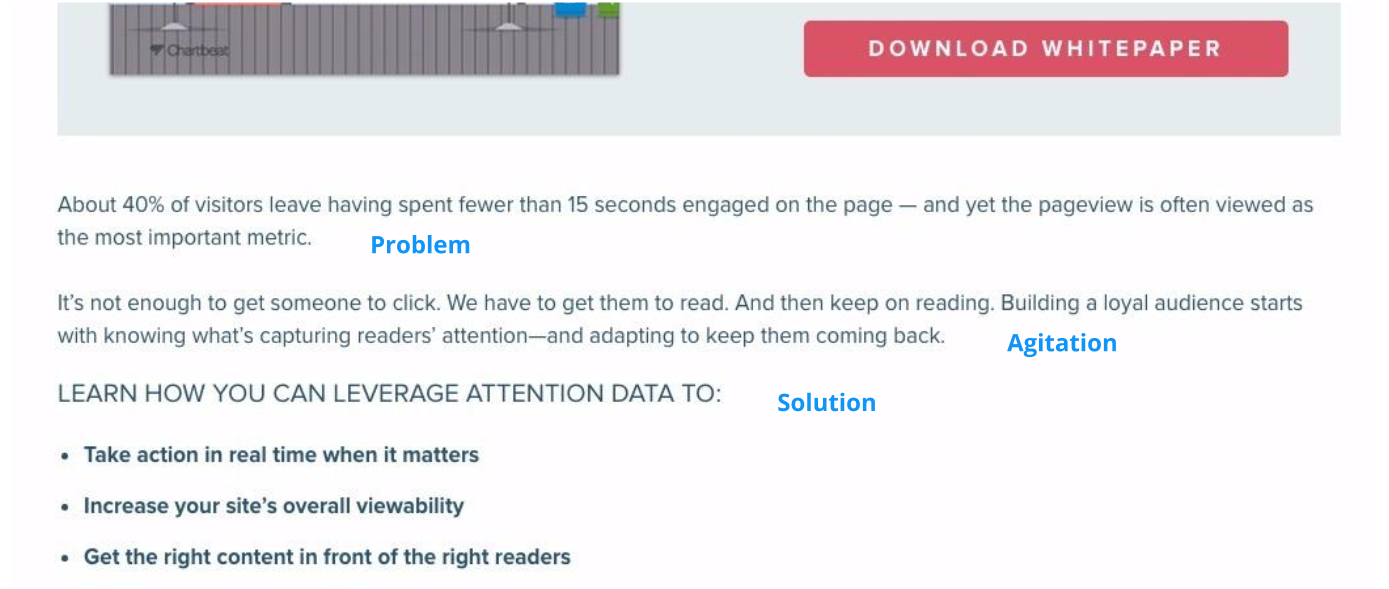
4. QUEST
The QUEST landing page copywriting formula immediately begins by qualifying your visitors. It works to prime them or ‘set them up’ for the rest of the content down the page.
Here’s how it works:
- Qualify your landing page visitor (usually with a question).
- Understand their experience and show your empathy.
- Educate your visitor about a better option.
- Stimulate their desire for that better option.
- Transition to take action or towards a sales conversion.
5. ROTI (Return on Time Invested)
ROTI, not to be mistaken with the tasty flatbread, is the approach of emphasizing a return on time invested. For most business owners and professionals time is their most important resource.
If you product focuses on solving a problem (which it should) and saving time it should be made clear. Anything that produces exponential value in a short amount of time is a godsend for professionals in sales.
6. AAPPA
In his book “How to Write an Advertisement” copywriter and author Victor O. Schwab outlined the AAPPA formula for persuasion.
The best part of this is the “Prove” section. Many formulas (the popular AIDA, for instance) leave that out, assuming you’ve done it. But explicit “proving” of the value of your offer is often the key component missing in un-optimized landing pages.
Let’s break it down and then take a look at an example from KlientBoost.
- Grab the visitor’s attention.
- Show them the advantage(s) of your offer.
- Prove the value.
- Persuade.
- Encourage an action.
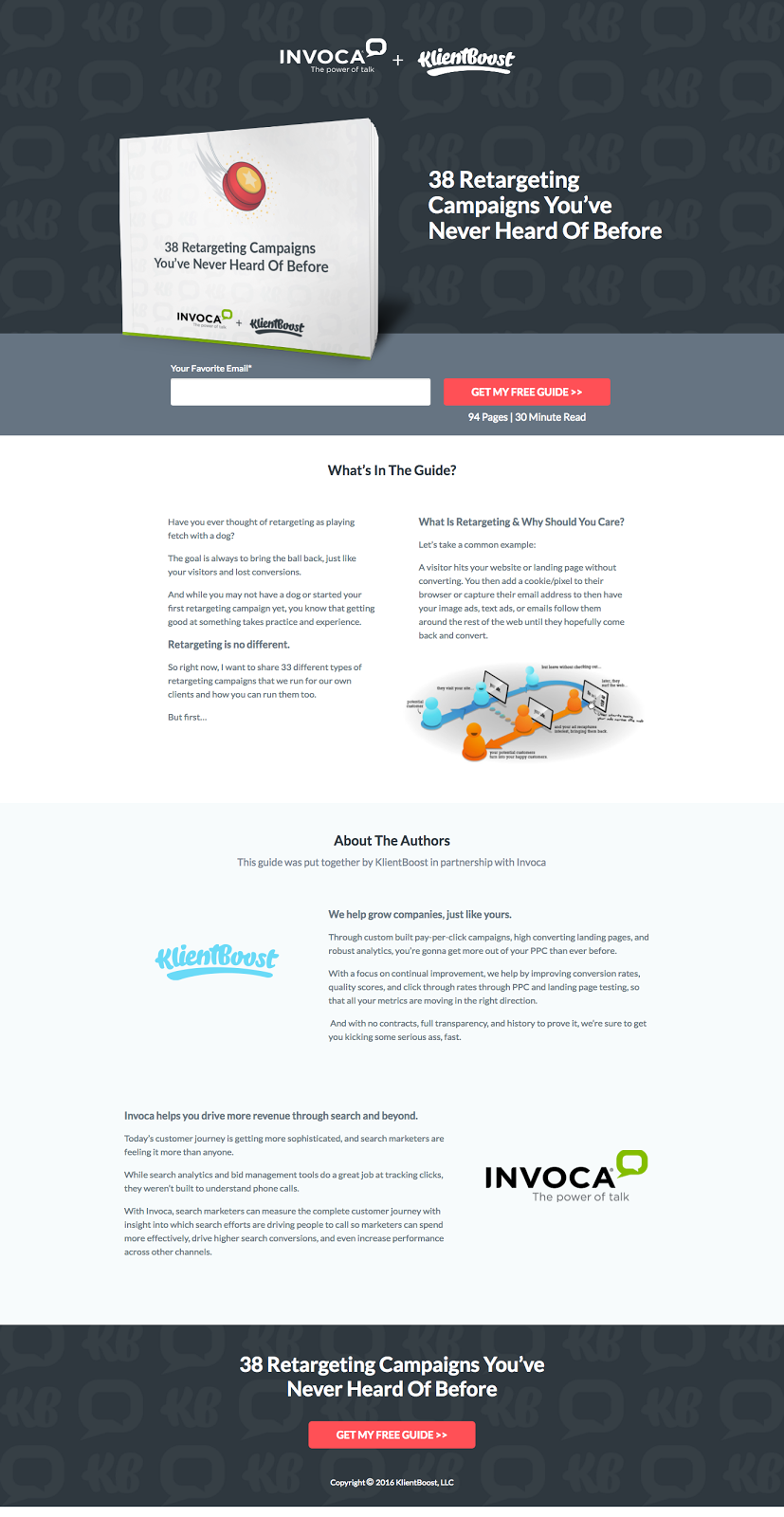
Landing Page Headline Formulas
7. The Ultimate Guide to [Good, Bad or Desirable Thing]
This is the most straightforward landing page headline for gated content. The ‘ultimate’ anything makes it immediately appealing. Superlatives like ‘ultimate’ creates a sense of curiosity that needs to be explored.
Examples:
- The Ultimate Guide to Google Advertising (Search, Display and Remarketing)
- The Ultimate Guide to Landing Page Design
- The Ultimate Guide to Using Customer Intelligence Data to Drive Retention
8. What Everybody Ought to Know About [Good, Bad or Desirable Thing]
“Everybody” is an extremely desirable clique to be a part of. If you’re out of the loop, you’re going to be left behind. People for the most part want to be part of the group, to be ‘in-the-know’. Appeal to the group mentality with this headline.
Examples:
- What Everybody Ought to Know About Running a Google Adword Campaign Before They Start
- What Everybody Ought to Know before Starting the Hiring Process for Developers
- What Everybody Ought to Know About Designing a Landing Page to Convert
9. X Lessons I Learned from [Person or Unusual Experience]
Whenever you add “I” to your landing page headline, you add first hand experience to the equation. Otherwise, who cares about your thoughts?
People love to hear recounted stories, and they love to hear about lessons learned.
Examples:
- 11 Lessons I Learned About Landing Page Design from the 2017 Growth Conference
- 5 Lessons I Learned About Presentation from Watching Guy Kawasaki Speak
- 7 Surprising Lessons I Learned About Design from Machu Picchu.
10. Break all the Rules and [World-class Outcome]
“Rules are meant to be broken” they say. It triggers our desire to “be bad” yet suffer no consequences. It appeals to ‘bad boy/girl’ in all of us. We want to be unique and we want to do what no one else has.
Use this headline to stand out and question the norm.
Examples:
- Break all the Rules and Create a Landing Page Optimized for Conversion
- Break all the Rules and Increase Ecommerce Checkouts by 112%
- How We Broke all the Rules at Content Marketing World and Got a Speaking Gig
11. How Your [Service Provider] Is Ripping You Off, And What to Do About it Right Now
Being “ripped off” is one of the biggest motivators for change. Being cheated drives anger, frustration and (most importantly) a desire to DO something about it. Nobody who’s been ripped off just moves on with their life.
Think about a time when you made a purchase and found out the exact product was 10% off at a competing store. It didn’t sit well with you did it?
Creating fear, therefore, of being ripped off, is a powerful headline for your landing page.
Examples:
- How [Big Corporate Company] is Ripping You Off, and How You Can Pay a Tenth the Price for the Same Service
- How Time Warner Cable is Ripping You Off, and What You Can Do About it
- How Paying for Printer Ink is Ripping You Off, and What to Do About it Right Now
12. I Found a [Adjective] Way to [Get Incredible Outcome]
This headline also uses “I,” but it’s actually the adjective which will drive the visitor to keep reading and engage.
Everyone loves a good shortcut. “Why work harder when you can work smarter” as they always say.
Appeal to the short cutting nature that most people desire. Most want results and they want them now.
Examples:
- I Found the Best Way to Generate Leads from a Business Blog
- I Found a Reliable Way to Turn Top-of-Funnel Leads into MQLs with a Single Email
- I Found the Proven Lead-Nurturing Drip Campaign Used by the Top Marketers
13. Let me Show you the Secrets of [Powerful Group]
Secrets. They’re the basis of success for everything from TMZ to Dan Brown and Indiana Jones.
The common person will always want a peek behind the curtain. We’re always left scratching our heads after watching a magician perform their tricks.
If you have insider information to share people will be lining up in droves to hear it.
Examples:
- Let me Show You the Secrets of the Most Successful Sales Teams
- Let me Show You the Secrets of the Banks That They Don’t Want You to Know
- Let me Show You the 10 Secrets of Mailchimp’s Success
14. People Regularly Pay Me [$] for This Information, But You Can Have It FREE.
When there’s a big dollar value at stake people pay attention. If you have proven value to bring to the table most would be wise enough to heed your advice.
Examples:
- People Regularly Pay Me $250/hour for This Information, But You Can Have It FREE.
- Major Corporations Pay Me $250/hour for a Consultation, But (for a Limited Time) Get my Top 10 Sales Strategies for FREE.
- Microsoft Paid Me $2,500 for these Strategies, but You Can Get Them for FREE.
15. How to Make [$] With Your ____________, Step-by-Step
Money talks. Plain and simple. And if you can show someone the step-by-step process used to achieve a specific dollar amount they’ll listen. Who would want an instant guide to success?
Examples:
- How to Make $10,000 a Month With Your Blog – A Step by Step Guide
- How to Save $1000s on Google Adwords – A Step by Step Guide
- How I Made $13,540 from a Conference – A Step by Step Guide
16. UPWORDS Formula
Universal Picture Words Or Relatable, Descriptive Services
The main strategy here is to take a concept that is universally understood and relate it to your offer in the most descriptive way. Its goal is to create a mental image for the reader and then relate it to a problematic concept.
Examples:
- Social Media Training Wheels: The Basic Strategies Every Social Media Manager Should Know
- Uber for Babysitting: Never Cancel Date Night Again
- 10 Commandments of Google AdWords Every PPC Manager Must Follow
17. The Complete Library of [large #] Free and Low-cost [Desirable Resources]
This is the one-stop-shop guarantee headline. Do you have the end-all-be-all of resource guides for your audience?
If so, use this headline formula to promote the fact that you’ve done all the heavy lifting and aggregated everything into one place.
Examples:
- The Complete Library of 501 Free and Low-Cost Stock Photos
- The Complete Library of 100 Content Marketing Tools
- The Complete Library of 200 Landing Page Examples to Inspire Your Business
18. Here Is a Method/System That’s Helping [Blank] to [Blank]
It’s the specificity which makes this headline such a good one:
- Here’s the specific strategy
- Here’s the specific successful person/company affected (case study)
- Here’s the concrete result
Approach this with concrete numbers and examples all it’ll be an added bonus. This headline promotes insider information that the reader wouldn’t receive otherwise.
Examples:
- Here is the System That’s Helping Freelance Content Marketers Break the Bank
- Get the System That’s Helping Facebook Advertisers to Double their ROI
- Get a Guide to the Strategy Groove used to Grow a 500,000 Visitors/Month Blog
19. Little Known Ways to [Blank]
This headline promotes that you’re privy to secrets not available to anyone else; secrets that only you’ve observed. It appeals to the curiosity one might have, using the insight that an industry pro, not an amateur, might have.
Examples:
- Little Known Ways to Turn Leads into Sales Without Email
- Little Known Ways to Turn your Blog into a Conversion Machine
- Little Known Ways to Use Everyday Household Items into Cleaners Better than the Store’s
20. [X] Factors That Could Affect Your [Thing in Which Reader Has a Vested Interest]
Immediately you’re pressing on a pain point that your reader has with a reference to the solution.
People are more affected by loss than they are by gain, so if you can draw a visitor’s attention to a prospective loss (something only held off by downloading your ebook, attending your webinar or starting your free trial) they’ll be motivated to take you up on it.
Examples:
- 10 Factors That Are Affecting your Blog’s Bottom Line (Without You Even Knowing It)
- 10 Factors That Are Ruining Your Chances of Adwords Success
- 15 Factors That Could Affect Your Email Open and Clickthrough Rates
21. The Secret of [Desirable Thing]
This taps into the curiosity section of our personalities. Someone would like to know how to do [X] and you’re going to show them how to.
Everyone wants that little thing that propels them into success (if only it were that easy). Focus on providing that ‘secret info’ by hinting you have the answers.
Examples:
- The Secret to Getting 1,000 Email Subscribers
- The Secret to Infinite Wealth and Happiness
- The Secret to This Young Billionaire’s Success
22. Do you have the courage to [do something very desirable]?
This headline directly addresses an insecurity: courage. Does this person have the courage to do [X]? Do they have it in them to succeed and do they have the will to learn?
Remember to keep the emotion you’d like to appeal to in mind when using this headline format.
Examples:
- Do you have the courage to quit your job?
- Do you have the courage to invest?
- Do you have the courage to join this movement?
23. I Stopped [Doing Common Thing] Today. You Should Too. Here’s Why.
Sometimes going against the current attracts more attention than going with it. The nail that sticks out gets hammered they say.
Go against the grain with this headline formula to catch a reader’s attention.
Examples:
- I stopped brushing my teeth for a month. Here’s what happened.
- I stopped eating like crap today. You should too. Here’s why.
- I stopped sleeping for 8 hours. Here’s why.
24. Who doesn’t like {somewhat accepted taboo}? {Unexpected answer with tease about why.}
Start by agreeing on an accepting taboo then quickly tease with an unexpected answer. The unexpected answer to a common acceptance makes readers do a double take.
If this formula doesn’t sound familiar, it’s used by news outlets every night. For example, ‘She went for a simple wisdom tooth removal, she woke up with a surprise — news at 11:30’.
Examples:
- Who doesn’t like donuts. This 5 year old monkey will change your mind.
- Who doesn’t enjoy a cold beer. Here’s why you should stop at 2.
- Who doesn’t like free flight upgrades? Here’s why you shouldn’t take them.
25. I spent {time} {working toward goal}. I just {quitting statement}. Here’s why.
Touch on a bit of personal experience. If you’re on a journey to reach a personal goal or battling with a problem, chances are someone else is as well.
Appeal to commonalities with this headline formula.
Examples:
- I spent my life worrying about my weight. I just let it all go. Here’s why.
- I spent 10 years climbing the corporate ladder. I quit to travel the world. Here’s why.
- I spent 20 years ‘following my passion’. I just discovered it was a mistake. Here’s why.
26. I don’t regret {X}. But here’s what I’d do differently.
Have an opinion about a well-agreed upon subject? Use this headline formula to spark up some controversy. Having a strong opinion on a subject often elicits curiosity and debate. People like hearing what they want to hear and will debate anything else otherwise.
Create controversy and spark up discussion with this headline formula.
Examples:
- I don’t regret my college degree. But here’s what they should’ve taught me instead.
- Photography school was great. But here’s what they should really teach.
- I don’t regret my marriage. But here’s what I’d change.
27. Would you {do unimaginable thing}? I just did.
Recounting an unimaginable scenario makes for a very compelling story. People are always fascinated by those who operate outside of the box or outside of the norm. This headline touches on that fascination with obscure behaviour.
Examples:
- Would you spend $200 on McDonald’s? I just did.
- Would you ungate all of your content? I just did.
- Would you spend 30 days with food? I just did.
28. String of Pearls
The string of pearls formula refers to lining up a series of compelling points or stories. You may also know these article as listicles. The headline references a specific number of compelling points you may have. The number plays a huge role in determining the perceived value of the article. A large number is perceived as overwhelmingly valuable.
Examples:
- 200 Website Popup Examples: The Last Resource You’ll Ever Need
- 100 Growth Hacks Learned From 5 Years as a Startup
- 500 Landing Page Best Practices
29. The Personal Testimonial
The personal testimonial formula only requires 2 things: a story and a lesson. What story can you tell your audience and what lesson did you learn from it? The personal testimonial is great for those trying to build a personal brand and engage with their audience.
The content is personal but try and balance it with the lesson of the article. The format choice is up to you ask long as it is spoken in the first person.
Examples:
- I Used Wishpond for a Year. Here’s what happened.
- I Stopped Drinking Coffee and Something Big Changed.
- I Stopped Collecting Email Addresses and Conversions Went Up, Here’s Why.
30. The 4 C’s
The 4 C’s are a simple rubric for checking that each part of your headline is operating to maximum effect. Each point has the specific purpose of making your headline efficient and impactful.
- Clear: Is the point you’re trying to make blatantly clear? Or is it ambiguous? Are people confused when they read it? Read it out to a friend or coworker and see if they know what the content is about.
- Concise: Is your headline to the point? Or is their a lot of fluff weighing the headline down? Can some words be eliminated to tighten it up? We want the headline to be read fast and the subject to be immediately recognizable.
- Compelling: Does it evoke a specific emotion with the reader? Does it make them want to act, to claim your offer?
- Credible: Does your claims have credibility? What should make them pay attention to what you have to say?
31. The 4 U’s
Like the 4 C’s, the 4 U’s is an alternative rubric to follow to hone in on the reader. It’s meant to target an emotion and really dig into the meat of the problem with maximum efficiency.
- Useful: Is what you’re trying to say useful to your audience? Or has someone said it already? Are you building on what has already been said?
- Urgent: Does the language create a sense of urgency? Or is it too casual? An abandoned cart for example, can be the result of someone not feeling like they need your product right now.
- Unique: Is your message unique? Does it stand out and make the reader question something?
- Ultra-specific: Is your message specific? Or is it confusing and difficult to understand without further exploration?
32. Open Loops (Zeigarnik Effect)
You’ve likely experience an open loop several times in your life. An open loop is simply something left unfinished. Studies have shown that people are more likely to remember something that is left unfinished as opposed to something that has.
A cliff hanger at the end of a TV show for example, stays in the mind of a viewer and keeps them hanging on till the next episode.
Use this headline by creating an open loop. Create curiosity with the headline so the reader has the urge to continue and find the answer.
Examples:
- We Tested 300 Landing Page Headlines For Emotion. Here Are The Results
- One Simple Little Trick Increased Conversions By 50%
- David Quit His Job 1 Year Before Retirement, Here’s Why
33. Features – Advantages – Benefits
FAB — easy enough to remember right? This headline formula is a straight shooter. Highlight the features of your offer. Differentiate it from the competition. Then elaborate on the benefits of it and what problem it solves.
Examples:
- Marketing Strategies For Startup CEOs. Tips from Startup to IPO.
- The Most Simple Social Media Management Software. Waste Less Time And Engage More.
- Complete Social Media Management. Schedule More Updates and Get More Clicks.
34. Address the 5 Basic Objections
When reading your headline a visitor will likely come up with reasons to not click or continue on. Their reason will likely fall into one of these five buckets. Keep these in mind and do your best to address one of them. Addressing all five would be wonderful. Addressing one would still be great.
- I don’t have enough time.
- I don’t have enough money.
- It won’t work for me.
- I don’t believe you.
- I don’t need it.
Examples:
- Download 5 Gorgeous Stock Photos for FREE
- Build A Landing Page That Converts in 5 Minutes
- Go From 0 to 1,000 Email Subscriber in a Month [Case Studies Inside]
35. A FOREST
The headline formula A FOREST is an amalgamation of different techniques mixed into one. To use this formula pick a combination of the following techniques:
- Alliteration
- Facts
- Opinions
- Repetitions
- Examples
- Statistics
- Threes (Repeat in threes to make it memorable)
Don’t try and use all of them at once. Find a unique angle to apply these techniques with and you’ll come up with a tasty headline.
Examples:
- Trending Titan: How Social Media Heavyweights Convert Customers
- How Neuroscience Marketing Might Actually Be Hurting Your Conversions
- What Does A Trustworthy News Article Really Look Like? 16 Pro Tips
Landing Page Call-to-Action
36. I want to ______
By using the word ‘want’, this CTA button implies action. The word connects with an inner desire to accomplish a specific action. By clicking this button the visitor is strongly say “yes I want this.”
Examples:
- I want to claim my spot.
- I want to learn to make money.
- I want to grow my business.
37. Save My Spot
For an event or webinar, “Save My Spot” is effective because it communicates exclusivity and scarcity. Visitors registering for a spot in the event or webinar will feel an air of exclusivity when their spot is secured.
This example from AutoPilot + Lift pictured below uses ‘Save My Spot’ to register webinar attendees. It expertly makes the webinar seem high profile and limited in space.
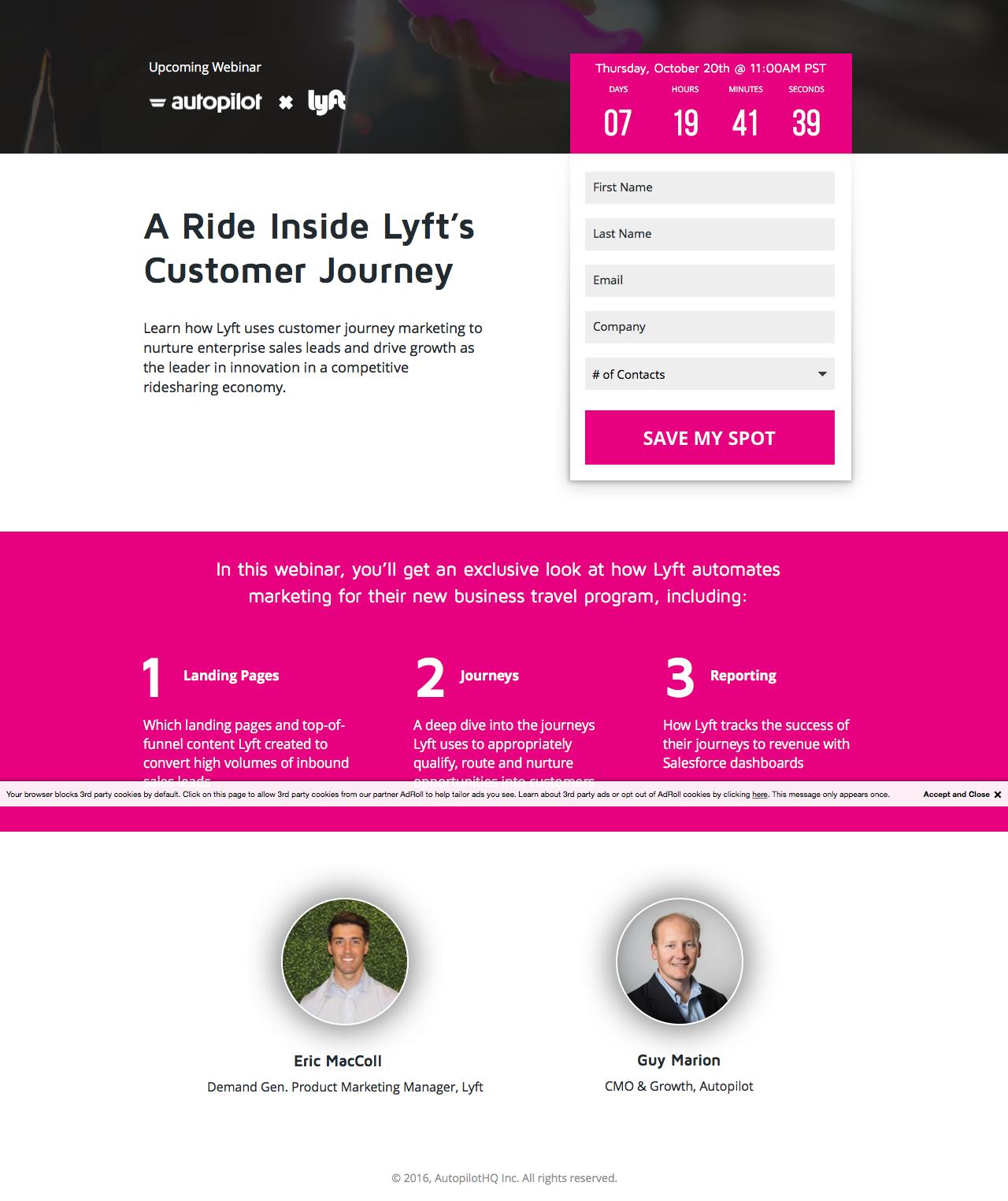
38. Get Instant Access to ______
‘Instant access’ to anything means immediacy. Tell you visitors what will happen next with this CTA button text. One strategy to improve conversions is to tell visitors exactly what the next step is. Using this button text will attract clicks because it is precise and explicit as to the next steps: a download.
Example:
- Get instant access to the resources.
- Get instant access to event.
- Get instant access to promotion.
39. Send me the free ___________
Your resource is on the way. Like the previous button, this one will tell visitors that the resource they want is on its way. It also includes the fact that it is cost-free so commitment is nothing.
Example:
- Send me the free ebook.
- Send me the free resource.
- Send me the free templates.
40. Unlock __________ for Free
Using the word ‘unlock’ implies access to a secret or coveted resource. By allowing your visitors to ‘unlock’ something you’re being generous and giving them access to something otherwise hidden.
Example:
- Unlock the Ebook for Free
- Unlock the Resources for Free
- Unlock Article for Free
41. Yes, I want to [achieve goal]
Get your visitors to confirm ‘yes!’ By using this button language you are prompting your visitors to say ‘yes’ I want this offer. This language forms more desire for the offer if the visitor has to consciously click “yes I want this.”
Example:
- Yes, I want to Grow my Business.
- Yes, I want to generate more leads.
- Yes, I want to fix my marriage.
42. Download [Offer] (P.S. It’s Free!)
Download [Offer] works well because it explicitly tells the visitor the action they’re about to accomplish. Being explicit about your visitors next steps will add trust and credibility to your offer, thus be more convincing.
Example:
- Download this ebook (P.S. It’s Free!)
- Download this photoshop template (P.S. It’s FREE!)
- Download this webinar (P.S. It’s Free!)
43. Tell Me More
‘Tell Me More’ entails a second or third step in the process. If a landing page is the first page before a second page with further details ‘Tell Me More’ is a solid CTA choice.
Marie Forleo uses this CTA language on this landing page to get visitors through the door. It then takes visitors onto a second page with the full B-School details. This step by step process is great for convincing visitors further and immersing them in information.
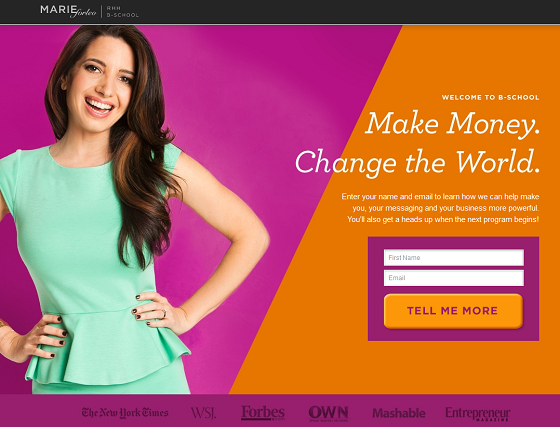
44. Become a ____________
This landing page CTA button is for those who are offering some sort of education based product. The offer is purely aspirational so the button language reflects that. Visitors are opting in to become something. Add in a prospected timeline and you’ll have yourself a very tempting offer.
Example:
- Become a better blogger in 30 days.
- Become a conversion rate expert.
- Become a better writer in 30 days.
45. Find a ___________
For landing pages related to connecting customers with services, ‘Find’ can be a powerful word. This button is implying action for those who have been searching for a result.
For those who have been searching for a dog sitter in their city, Rover offers to “Find a Sitter.” Visitors enter in their information and are instantly connected with a dog sitter in their city.

46. Grade __________
Free online tools are generally one of the best lead magnets a SASS business can offer. For just your email, you can access a powerful free online tool like WordStream’s AdWords performance grader. It is a sensational lead magnet for WordStream and offers tremendous value for visitors.
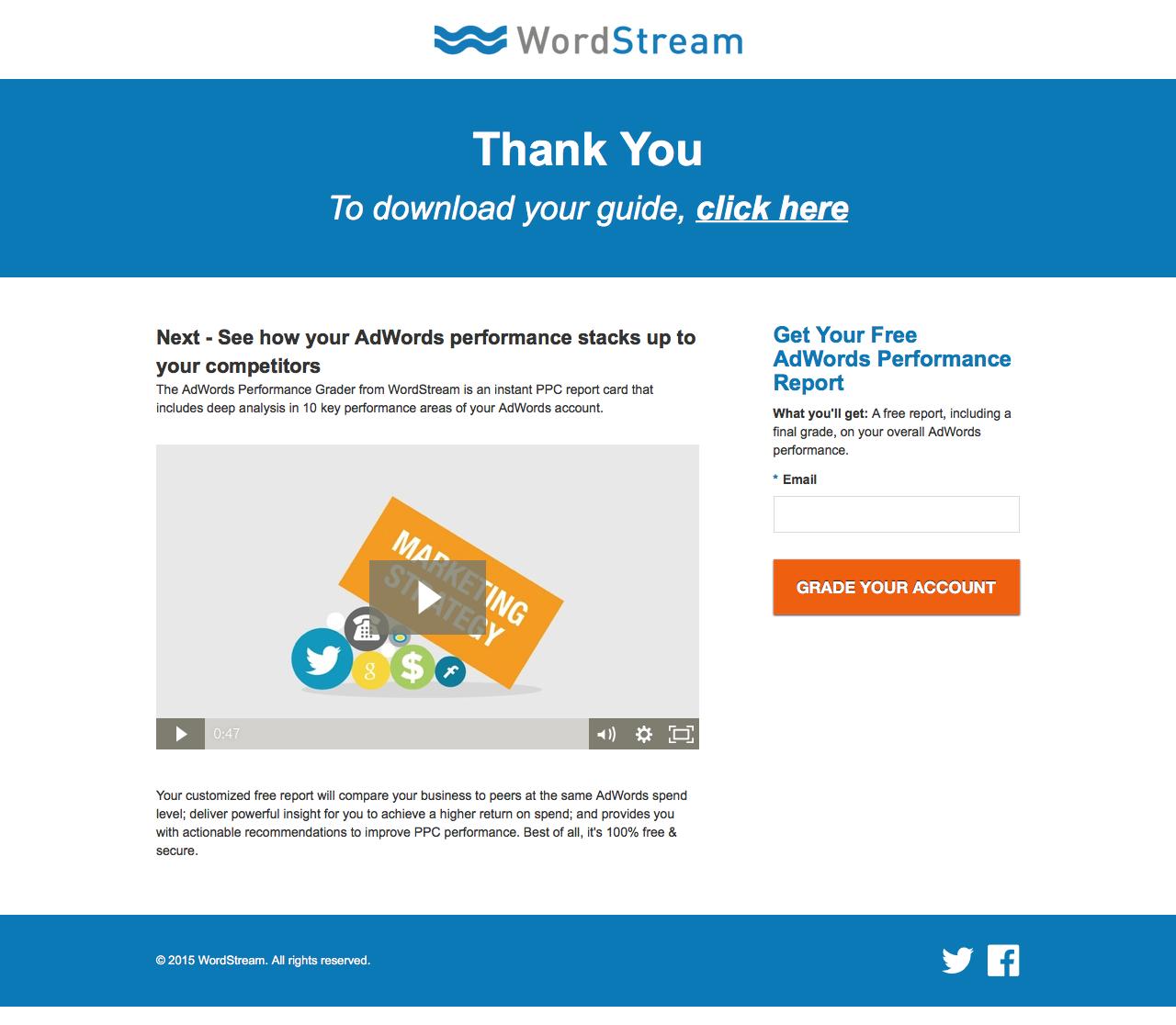
47. I’m In!
This CTA language is straightforward. Instead of opting in wholeheartedly with an emphatic ‘Yes!’ this CTA uses ‘I’m In!’ instead. In contrast to the ‘Yes’ button, ‘I’m In!’ sounds a tad more proactive and enthusiastic. By clicking this button visitors are joining your team so to say and opting into whatever you have to offer.
48. Take me to ___________
Moving visitors onto the next step in your marketing funnel can be tricky. This CTA might help ease the process by explaining where your visitors are headed next. Depending on your offer, your visitors will be reassured and taken onto the next steps.
Example:
- Take me to my free ebook
- Take me to my free guide
- Take me to the examples
49. Create ___________
Everyone likes to flex their creative muscles here and there. If you’re offering a product or service, creativity might sound like an appealing offer to your visitors.
Shopify knows a strong creative muscle does well in the Shopify platform. In addition to the 14-day free trial, new Shopify visitors can jump right in and create their first store.
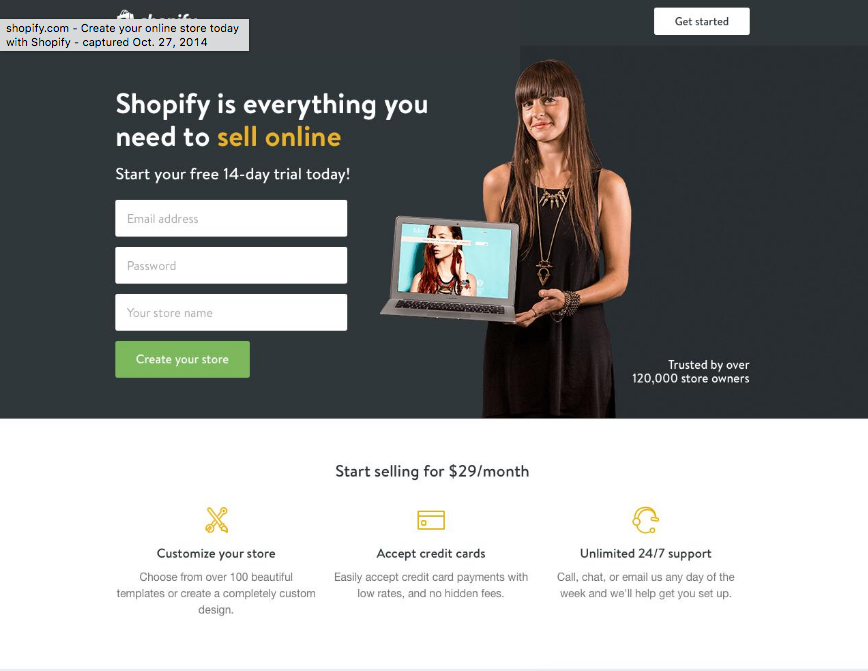
50. Claim my __________
There is no better way to piss off a potential customer than to not come through on your promise. If you’re offering an amazing lead magnet or promotional discount, the last thing you should do is make your visitors jump through more hoops than they’re comfortable with. It will more than likely lead to a bounce rather than a conversion.
Let your visitors know they’re about to claim your offer immediately with this CTA button text.
Example:
- Claim My Free Ebook
- Claim My 15% Discount
- Claim My Spot
51. Build my __________
Software as a service has many applications these days across a broad range of industries. Customers now have the privilege of building out orders before they pay for them. For example, you can build your truck with completed specs on Ford.com before you go into the dealship and buy. Encourage your visitors to get building with this CTA button text.
Example:
- Build My Tuxedo
- Build My Car
- Build My Analytics Report
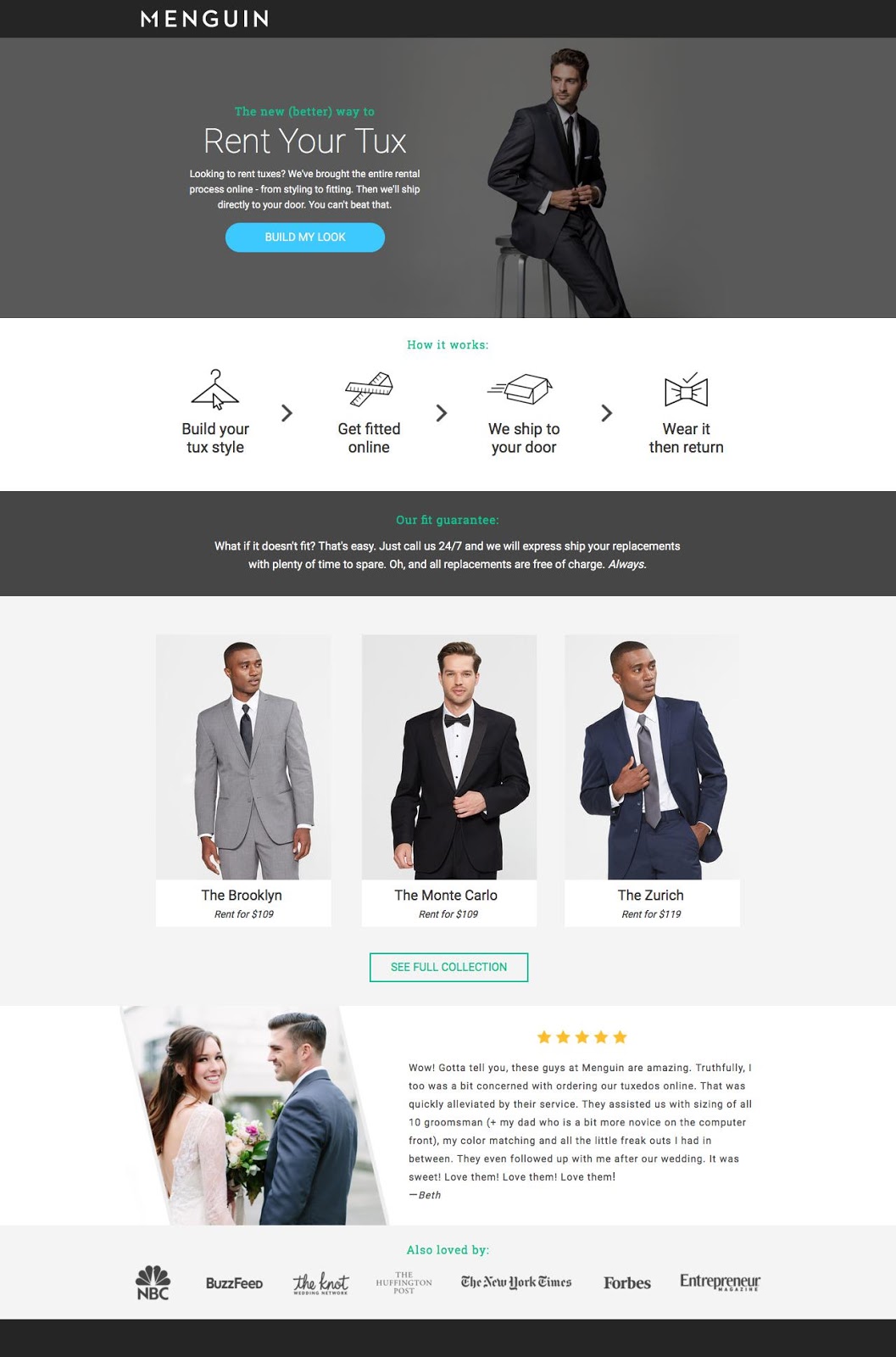
52. Start ___________
The path to success is simply to start, right? Get your visitors on the path to success and encourage them to get started right now with this CTA button text.
Example:
- Start generating more leads.
- Start growing your business.
- Start making money from home.
53. The “I Want”
This CTA formula is all about filling in the blank. There are 2 blanks to choose from:
I want to ____________
or
I want you to ___________
Let’s say you’re writing a button for a car website. You might complete those phrases, “I want to get a new car” and “I want you to show me the newest cars.” So the button copy would go like so, respectively:
Get a new car
or
Show me the newest cars
See the difference? And, yes, to be clear, in the second option, you do keep the first-person “me” in the button. That’s actually what makes it so powerful.
54. “Get _________”
This CTA button text is a favourite amongst many marketers — the “get”. Using “get” implies action for the visitors as if they’re physically accomplishing something.
Marie Forleo knows this and uses the word “get” on button CTAs to give visitors instant access to free business training videos.
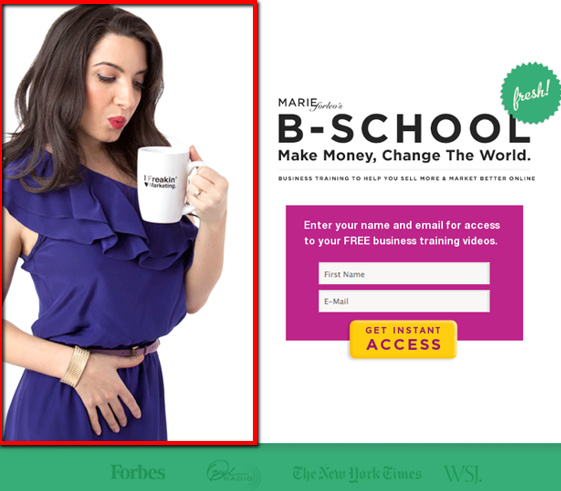
Want a magic word? Here you go: “get.”
People like to get things. There’s very little work or friction associated with getting (depending, of course, on what follows “get”). It generally suggests good things to come. So start your button with the word “get.” And make sure the phrase that follows matches your prospect’s desire and expectations.
55. RAD
The RAD CTA button formula stands for:
- Require
- Acquire
- Desire
When using this formula the very first thing you want to do is make sure you’ve clearly explained the offer first. Don’t prematurely place a button anywhere on the landing page before you’ve explained the information first.
According to RAD: First give your visitors the info they require, make the button easy to acquire (locate), then make sure your visitor desires what the button promises.
56. CPSC
This post describes 4 call-to-action considerations. They refer to copy as “text”, so Joanna Wiebe swapped that out, turning their TPSC into a Copy Hackers-friendly CPSC:
- Clear: Is the copy clear?
- Placed: Is the button placed well?
- Size: Is the button an easy and helpful size, not too big or too small?
- Colour: Does the button colour make it stand out on the page?
Like RAD above, CPSC is a rundown to make sure your CTA is providing the greatest impact possible.
57. Elements-of-the-Offer Formula
Admittedly, this formula is for the entirety of the landing page but the theory can be applied to almost any section. As long as the information on the landing page is presented in order, the CTA should fit right into place.
- Here’s What You’re Gonna Get
- Establish the Value
- Offer a (Conditional) Bonus
- Price
- Trivialize Price
- Guarantee
- Risk Reversal
- Scarcity
58. Hook, Line and Sinker
This CTA formula is courtesy of Wordstream. It’s great for ad copy but also text links and buttons. Here’s how to use it:
Command verb + offer + urgency
Examples:
- Download our whitepaper today!
- Access the templates now!
- Download your free report now!
59. Request _________
This CTA button text can be likened to ordering food at a restaurant, the visitor is making a request. Typically this button text is used for something of high value like a product demo from a sales representative.
Zype uses request to allow visitors to schedule a live demo of their platform with a sales rep.
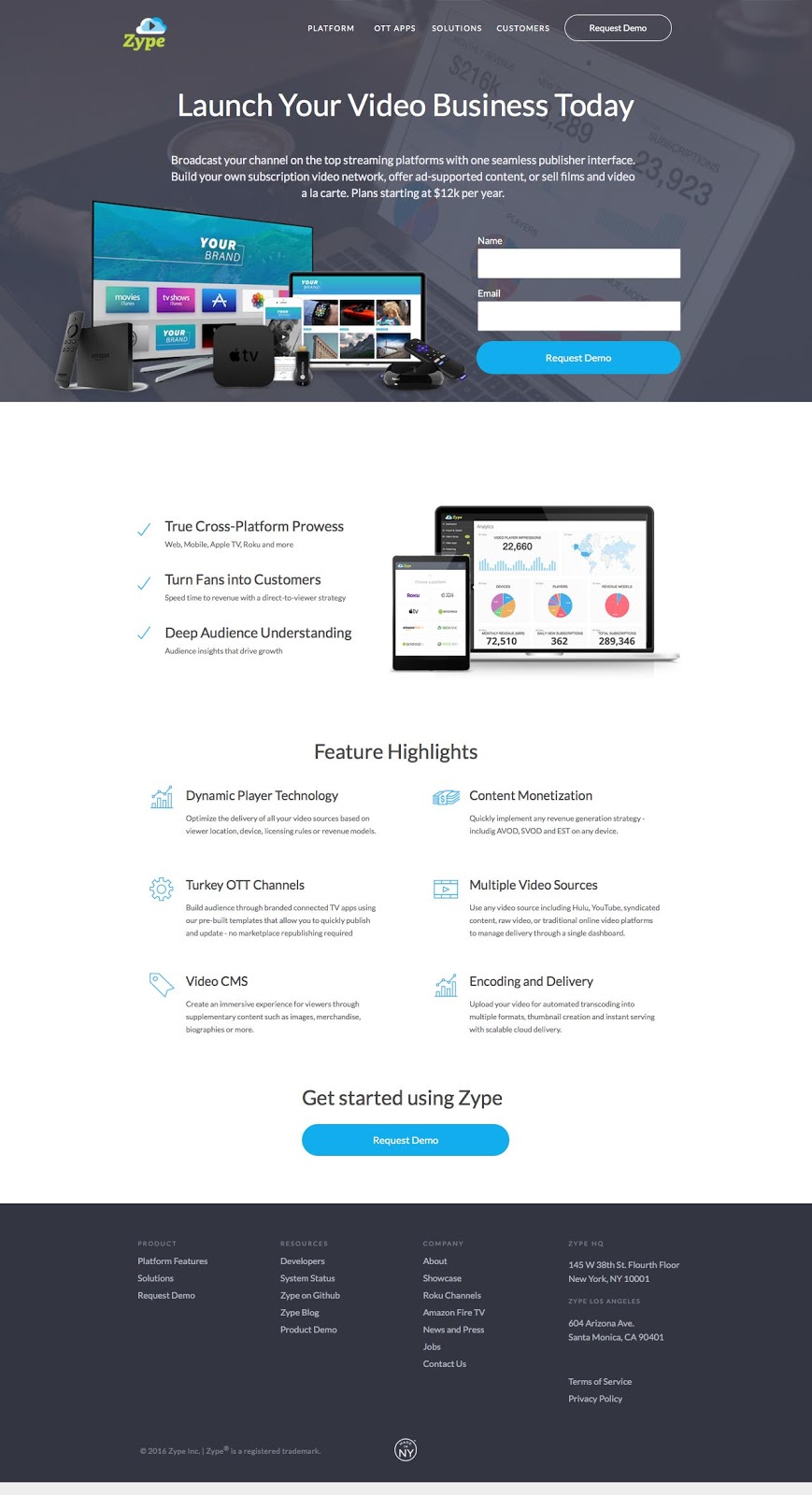
60. RSVP
For a simple event or webinar RSVP works much like it does in the real world. By clicking ‘RSVP’ visitors are claiming their spot for this exclusive and limited event.
YP Marketing Solutions uses ‘RSVP’ in the landing page below for their Local Breakthrough Summit. Visitors can book their seats today by RSVPing on the event page.
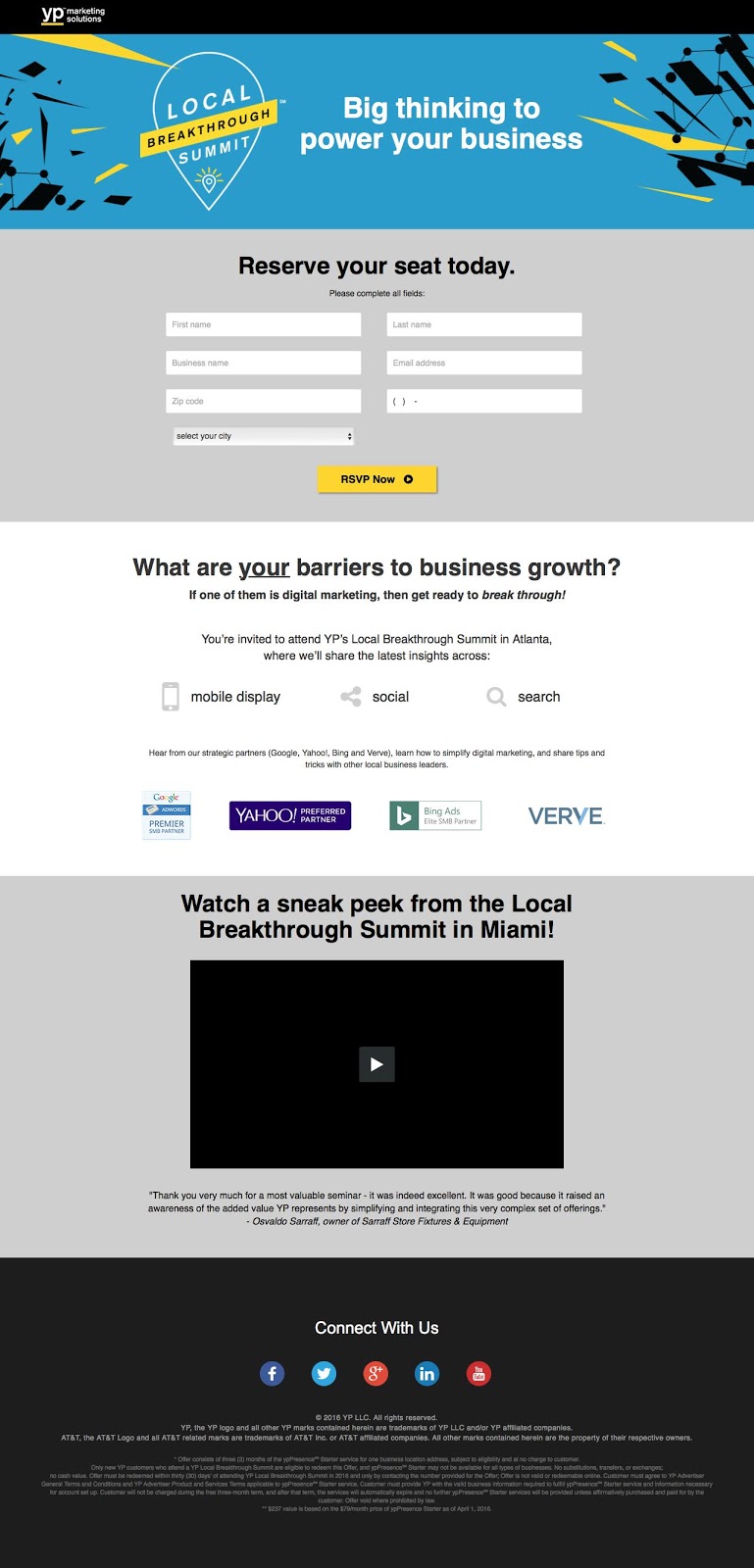
61. Join ________
Keep thing simple with this CTA button text and prompt your visitors to join you. For an offer like a webinar or access to a private group, join can be an effective prompt because it implies access to a group.
Front Webinars uses ‘join’ in the CTA of one of their upcoming webinars to have visitors confirm their attendance. Visitors are prompted to ‘join’ the group and be part of the select few who get access to the information.
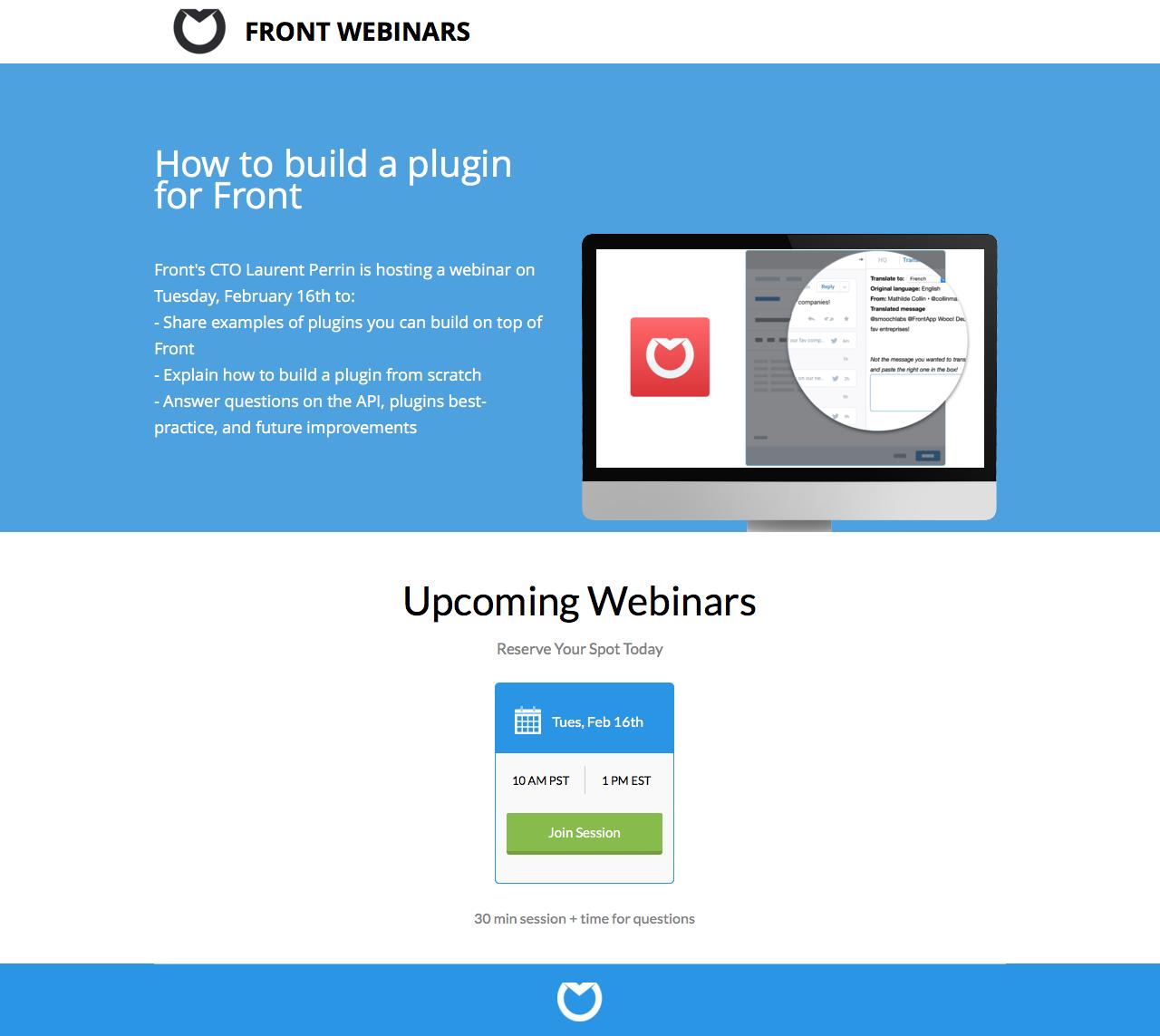
62. Teach me how to _________ (ie. retain more users)
Mastery of a skill takes 10,000 hours of practice says Malcolm Gladwell. If your offer is educational in format you’ll need to use a CTA button that reflects your offer.
Examples:
- Teach me how to retain more users
- Teach me how to reduce churn
- Teach me how to increase conversions
63. Situational
This particular CTA button text requires a bit of creativity to pull off. Depending on what industry your business is in, your CTA button text can be constructed to correspond with your offer.
For example, Cater2.me uses the words “Feed My Team” on their CTA button. It’s totally original and corresponds to their ability to feed an entire office. The language is kep action-oriented but adds an element of fun to the mix.
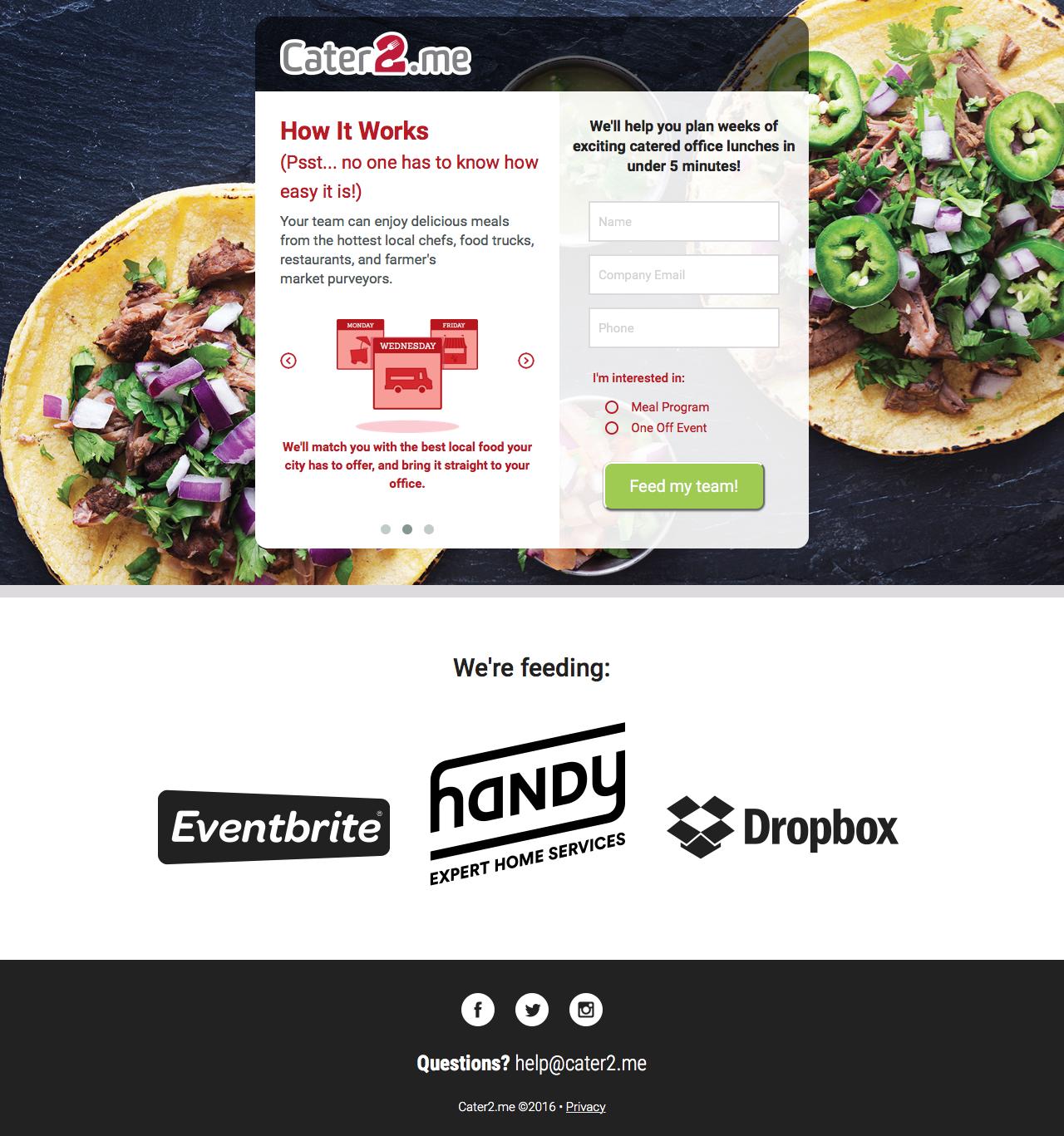
Landing Page Testimonials
Including testimonials on your landing pages are powerful additions to what marketers call “social proof”. Knowing that like-minded individuals in the industry have tried and had success with your product/service adds much more support for your claims.
Many shoppers rely on word-of-mouth recommendations for most of our purchases. A recommendation from a friend or colleague can be the deciding factor between you and your competitor. Use these tips to craft compelling testimonials for your next landing page.
64. The 4 Ss
Follow the 4 Ss formula to craft short yet compelling testimonials and add a power punch to your offer.
The 4 Ss are as follows:
- Specific: Get to the meat of the problem immediately. What specific problem did you solve for your customer?
- Short: Don’t weigh down the testimonial with too much information. Make it quick and snappy for maximum effect.
- Sizzling: Does this testimonial relate to the reader? Is the story compelling enough to create an emotional reaction?
- Signed: The last thing you want to do is use a fake testimonial. Back up the testimonial claims with the title and company of the customer.
65. Before – During – After – Favorite – Emotion – Ideal For
There’s no need to over complicate things when sourcing testimonials. If you’re strapped for time, sending customers this fill-in-the-blank template works wonders:
I approached {business name} because __________. {Person at business name} helped me by __________. The result was __________. One thing I liked was their __________. I found the experience __________. I would recommend {business name} to people who need __________.
66. TEASE
When editing testimonials for maximum impact simply remember TEASE:
Is it tactful?
Does it emphasize a particular strength of the solution or product?
What authentic part of the experience have you shared?
Is it short and sweet?
Does it engage the reader?
Body Copy Formulas
67. The APPROACH Formula
The APPROACH formula is a structure used to build out the information on the landing page.
- Arrive at the problem
- Propose a solution
- Persuade the listener on your solution
- Reassure that your solution is the best fit
- Orchestrate an opportunity to sell your solution
- Ask for action
68. So what?
This is a technique for reviewing each section of your landing page. Review each section and make sure you can answer “so what?” to make sure you’re addressing each hesitation a visitor might have.
Each section of your landing page should clearly communicate the problem you’re solving and the solutions you bring to the table.
69. Sell the Page
“Selling the page” is a mindset to keep in focus when constructing your landing page copy. The key to this formula is to sell the page and not the business. Ask yourself, how does the design and copy communicate your offer? Does it do everything in its power to drive visitors towards the conversion?
Before you can sell your offer, you need to have all of your bases covered. Don’t just sell the product, provide every piece of information that makes your product/offer stand out from the rest. Because if your visitor doesn’t convert, at least they’ll leave with some information.
70. Write to one person (your personas)
The key to failure is trying to please everyone they say. Don’t aim to write copy that appeals to anyone and everyone. Instead write for one person — your ideal persona. Hopefully you know a bit about your target audience and have developed personas to speak to.
Visitors respond more positively to communication that is directed towards them, that’s why we respond to email directed to us and ignore generic email blasts. Focus on writing for one.
71. Avoid plague words that waste time
When visitors land on your landing page you literally have seconds to capture their attention and pitch your offer. For most people time is money. Crafting concise copy is an artform and should be paid special attention.
Eliminate plague words or words that have no purpose. Say what you need in the least amount of words possible.
71. The 3 Why’s
Having trouble starting? Starting from a blank page can be a little intimidating especially when each section of a landing page is expected to provide maximum impact. That’s a lot of pressure!
That’s why it’s so helpful to have a formula or a set of guidelines to follow each time you face the blank page.
One solution to the problem is to follow the 3 Why’s:
- Why are you the best? Why should visitors choose you over your competitors? What makes your business stand out in the marketplace? Your USP?
- Why should I believe you? What is on the page that adds trust to your offer? What proof do you have of your success in the industry?
- Why should I buy right now? Can I wait a week? Why is this offer so great that I should claim it right now?
72. The 1-2-3-4 Formula for Persuasive Copy
Follow this 4 step process to address every hesitation a visitor might have when reviewing your offer. Compared to the 3 Why’s, the 1-2-3-4 formula presents the offer, explains what it’s going to do, who the company is, and what the next steps are.
- What I’ve got for you
- What it’s going to do for you
- Who am I?
- What you need to do next
73. Home Runs Only
“Home Runs Only” refers to not being afraid to swing for the fences with your copy. Go big or go home as the copywriting pros say.
Mavenlink shows this off perfectly in their headline, “Go Beyond Project Management.” Mavenlink isn’t afraid to claim that their product goes beyond any other product on the market. Don’t be afraid to bet big (just make sure you can back it up).
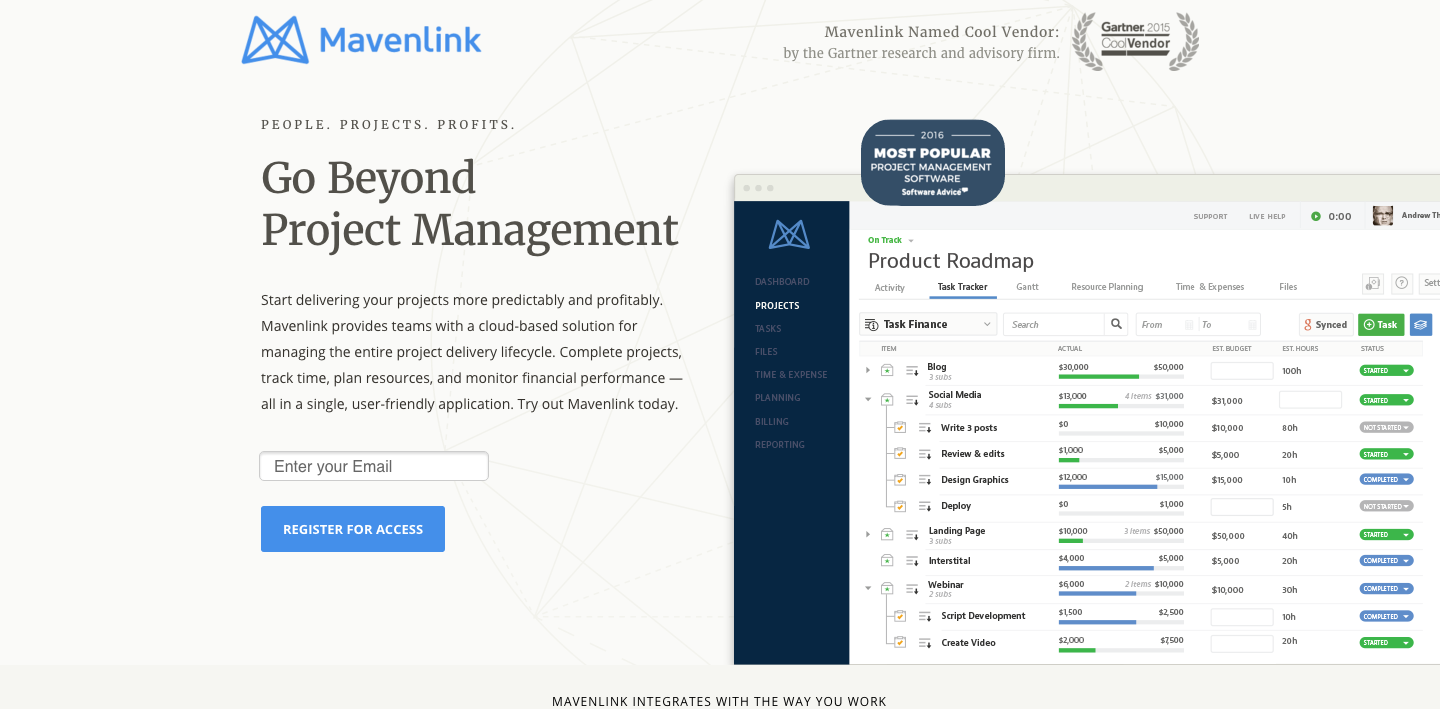
74. Break it up
Providing overwhelming value can often lead to quite a lengthy landing page. Remember that keeping text as short and concise as possible caters to the behaviours of online readers. These readers skim and gloss over much of the information and quickly decide if your offer is for them or not.
Help them out and make your landing page reader friendly by breaking up chunks of text. Use ample amounts of white space to focus attention where you need it.
Asana made this landing page as reader friendly as possible by breaking each section into chunks surrounded by ample white space. This smart layout lets readers focus in on the text and avoid distraction.
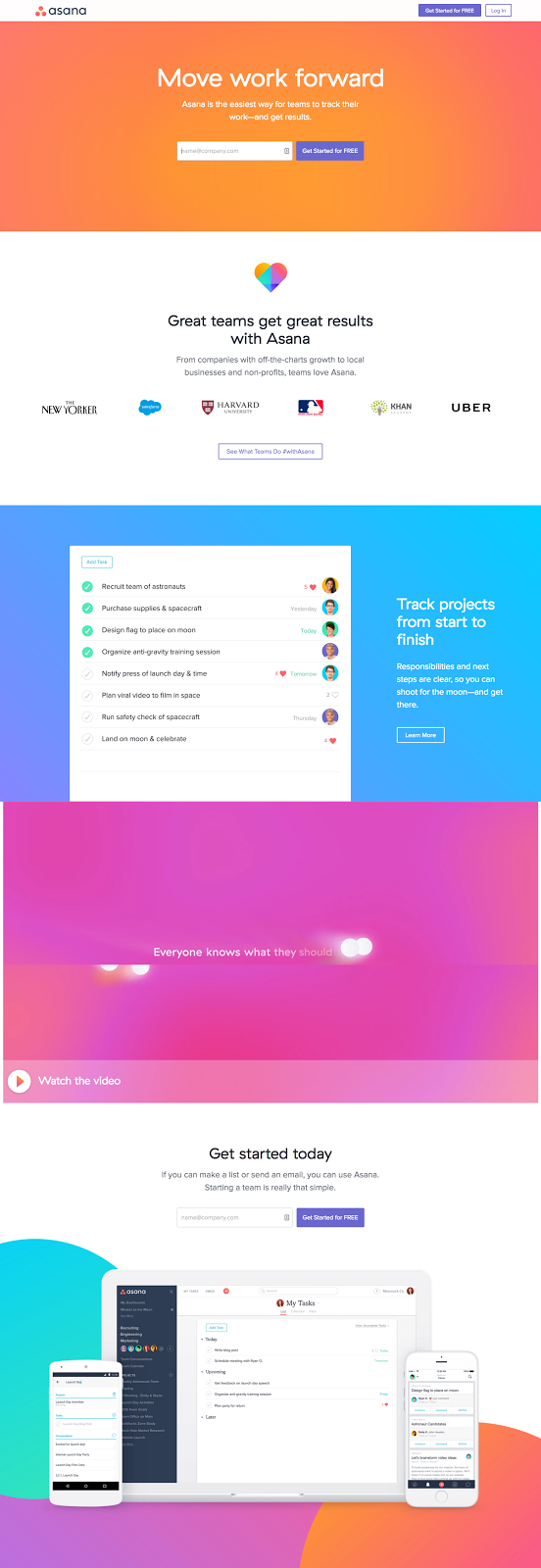
75. Emphasize the benefits, not the product
Explaining the ‘what’ of your offer if important but it shouldn’t be the only information on the landing page. When planning out what to put on the landing page, try highlighting the benefits rather than the product itself. Not to say presenting your product isn’t important but quickly move onto what your customer receives by choosing you.
Goodlife Fitness shows this off by highlighting their 3-day free pass at the top of the page then quickly moving onto the benefits for the member. They don’t focus solely on their offer (the free 3-day pass) but on the benefits that Goodlife members receive.
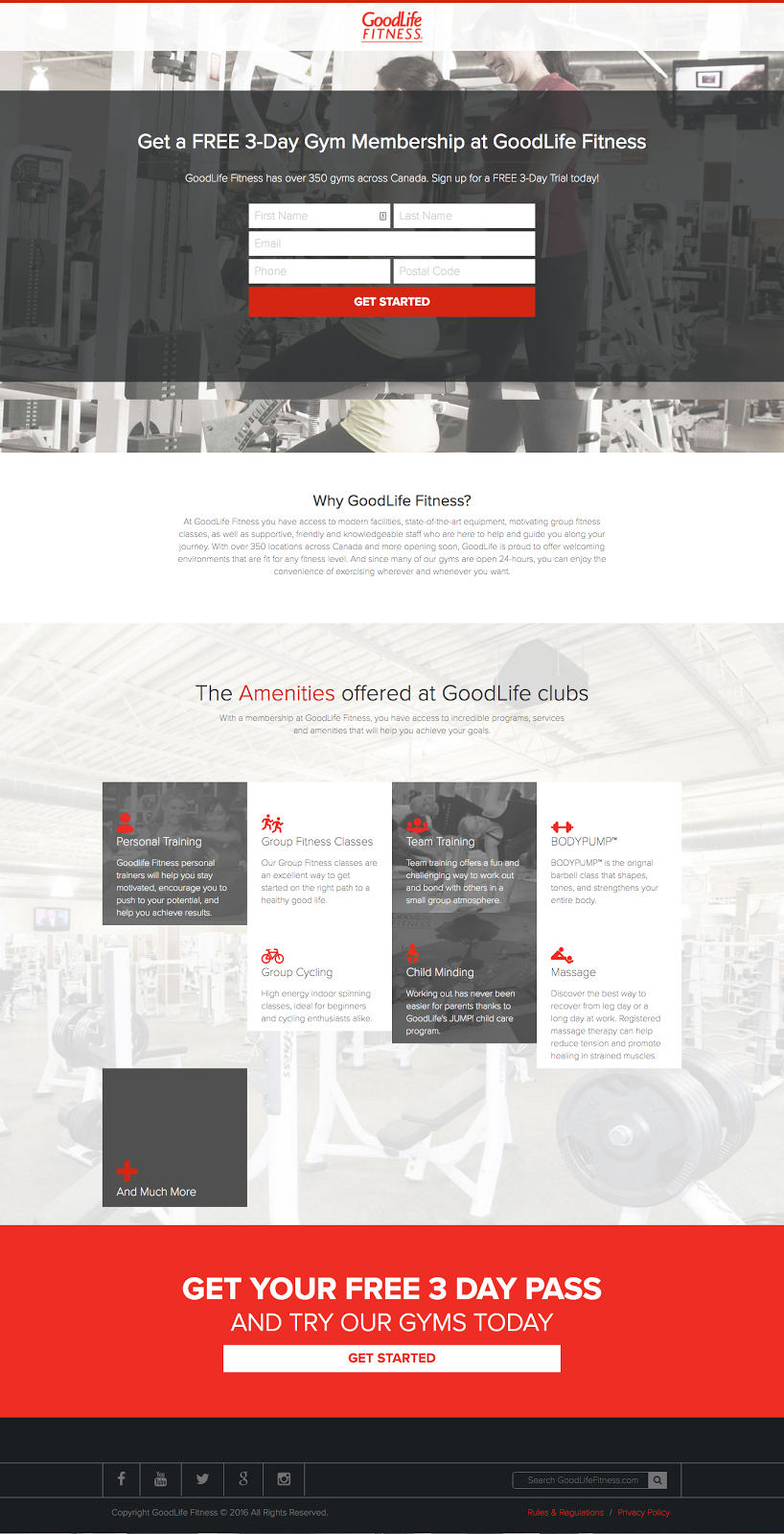
76. Write numerals not numbers
Here’s a quick little tip concerning the presentation of your copy. When writing numbers use numerals (3) instead of numbers (three).
Studies have shown that writing numbers in numerals have a more pronounced effect on copy because numerals stand out amongst letters. If you’re emphasizing data or claiming a numerical difference from a competitor use numerals to help the copy stand out on the landing page.
Marketing influencer Jeff Bullas uses this landing page to collect leads from his website visitors. Notice how the title of his lead magnet uses a large number (101+) to attract over 5 million visitors a year. Those are big numbers that are emphasised further in numerical form.
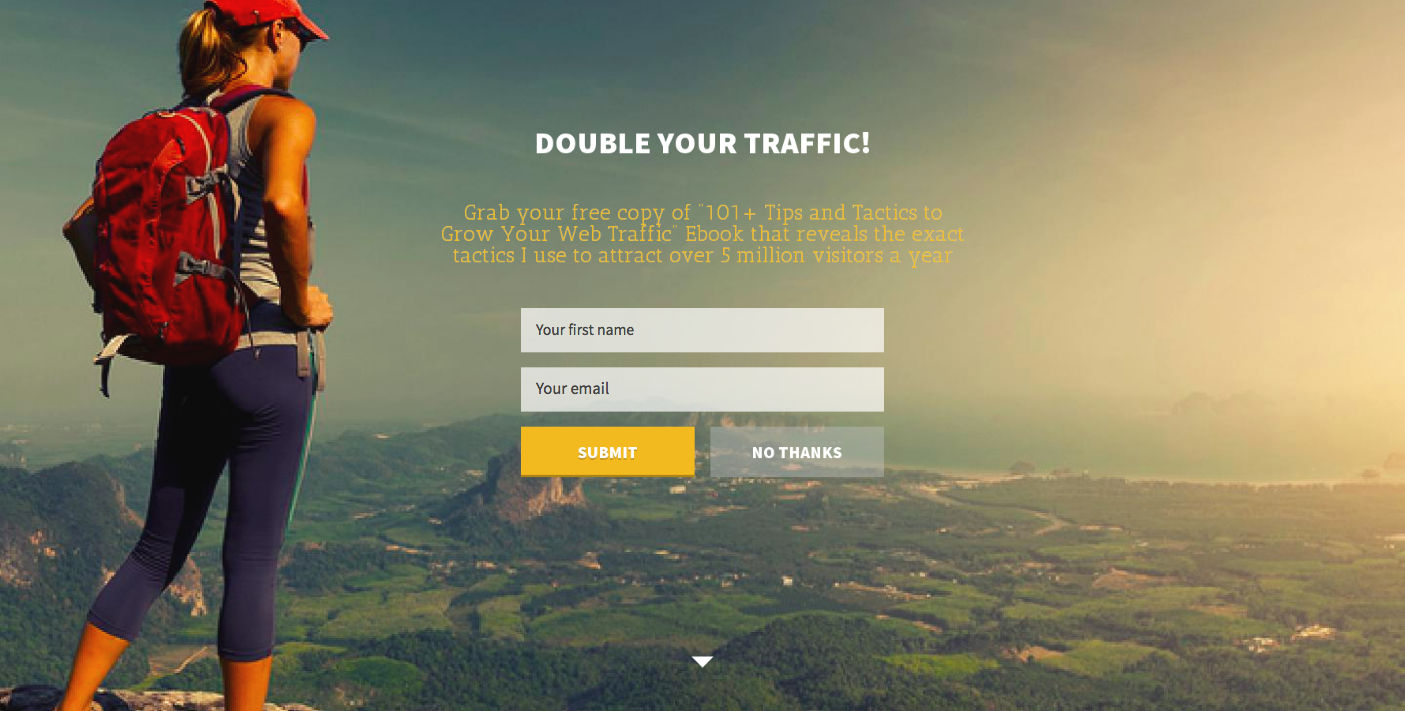
77. Write for scanners
As we mentioned before, online readers decide in seconds if your offer is for them or not. Instead of reading every piece of text on a landing page, online readers tend to scan. Their minds will highlight information that is pertinent to them and ignore things that don’t stick out.
When you’re constructing your landing page remember to write for scanners. Ask yourself:
- Is there ample white space around chunks of text? Or is too much information muddling the presentation?
- Are plague words and unnecessary points eliminated?
- Can some text be replaced with images instead to make things quicker?
78. Sonia Simone’s 5 Pieces Every Great Marketing Story Needs
If you haven’t heard already, content that is presented in a story format performs much better than content that is purely informational.
Use this formula to make sure your landing page content is presented like a story. Sonia Simone’s 5 Pieces Every Great Marketing Story Needs is a helpful checklist for making sure your landing pages have every element a compelling story needs.
- A hero
- A goal
- A conflict
- A Mentor
- A moral
79. Star – Chain – Hook
- Star – Your product/service/idea
- Chain – A series of facts, sources, benefits, and reasons
- Hook – The call to action
The star – chain – hook formula is similar to the previous ones but pay special attention to the chain. The chain is what information you’re going to include to support your star and hook. This could be unique data, case studies, testimonials, customer results or compelling use cases. The chain is entirely up to you depending on how you’d like to position your offer.
80. Symptoms
Here’s a formula that targets customer pain points. The purpose of using this formula is to get visitors to nod along with you as they continue down the page. In each section of your landing page you’ll highlight specific pain points a customer might be having and finish with the solution.
The key is to address their pain points to hold their attention as you make your way down the page. For example, start the page off with a question, “Are you tired of wasting 50% of your ad budget of garbage keywords?” Then move on to the reasons why a customer is wasting most of their budget. Use examples of typical scenarios and maybe throw in some customer success stories.
By the end you visitor will be nodding along with you and be invested enough to explore you solution.
81. Bob Stone’s ‘Gem’
This proven ad formula was created by, you guessed it, Bob Stone. It was originally used only for creating ad copy but it can be applied to a myriad of places.
- Start with your strongest benefit.
- Expand on this benefit.
- Explain how the reader can benefit.
- Back up your statement with examples, proof, or data.
- Tell readers what they’ll lose if they don’t act.
- Sum up the most important benefit.
- Include a CTA or ask.
Example:
Wishpond makes lead generation a breeze with a drag-and-drop landing page builder, exciting social contests and simple marketing automation. Thousands of businesses trust Wishpond with their lead generation efforts. Stop wasting time and start growing your business with Wishpond today.
82. Star – Story – Solution
- Introduce the star of the story
- Tell the star’s story
- Present the solution that helped the star achieve big things
Here is another formula for structuring your landing page. Again, this formula focuses on using your landing page to tell a story. First, introduce the star of the story: your offer or your product. Tell the story of the star and the problem. Then introduce the solution to their problem.
83. The Motivating Sequence
To use The Motivating Sequence you’ll first need to find out what’s motivating your reader. Grab their attention and identify their most major problem. Hint at your solution. Provide the answer further down the page. Finally ask them to take action.
Here is the sequence of points you’ll need to hit:
- Get your reader’s attention
- Identify a problem or need
- Position your answer
- Prove your answer
- Ask the reader to take action
83. The 6 +1 Model
- Context
- Attention
- Desire
- The gap
- Solution
- Call to action
- +1. Credibility
This model begins with context, something that gets the reader to relate to your offer. Move on and address the gap in the market that you’re looking to solve. Present your solution and provide a call to action. Don’t forget to add credibility, ie. a testimonial or endorsement.
Example headline:
Get The Tools Wishpond Used To Grow Their Blog To 300k Readers A Month
84. Enormous problem. Solution. Core differentiator. Credibility.
Like the previous formulas, this one is equally as simple to use on landing page copy. This formula works well at simplifying the whole layout of the landing page copy from start to finish.
Take a look at this example from Joanna Wiebe:
Content marketing is the fastest-growing opportunity for businesses, but content creators can’t churn out great content like factories. We offer a collaborative writing platform – called Airstory – that houses a team’s ideas and research alongside their documents, so they can simply search their research library, find ideas, drop them into a document, and publish. Created by a blogger, content strategist and novelist.
Copywriting Value Propositions
Like a general barking commands on the battlefield your landing page copy has many responsibilities. Your copy must first hook a visitor and convince them to explore the page. Then it must lead them downwards to explore benefits all while building up perceived value.
To maximize the perceived value of your product or offer you’ll need to employ a well-written value proposition to tie everything together.
87. VAD: Verb, Application, Differentiator
This is a simple formula to hone in on what exactly your value proposition is. Choose the verb your business accomplishes. Attach that verb to the application of your business. Then differentiate it from your competition.
Example:
- Drop research directly into blog posts and articles.
- Manage all of your social media channels in one window.
- Visualize all of your financial data wherever and whenever you want.
88. For {target} who {statement of the need or opportunity}, {Name} is {product category} that {statement of benefit}.
This value proposition formula is simple, fill in the blanks and focus on the benefits. What makes this formula particularly great is that it addresses every customer hesitation in one (long) sentence.
Example:
For businesses that rely on high value leads, Wishpond offers drag-and-drop lead generation tools and simple marketing automation. Start collecting more leads and making more sales.
89. We do X, but the difference is {primary differentiator}.
What we like about this value proposition formula is the clarity. It starts by stating that ‘we do [X]’ so that the reader forms a clear picture in their mind. Then it flips that picture on its head by stating how ‘we do [X] differently.’
Example:
We help businesses collect more leads, but the difference is that Wishpond makes the process from lead to sale absolutely pain-free.
90. The {adjective} way for _____ to _____, {benefit/outcome}.
This plug-and-play value proposition formula highlights the benefit even more so than the others. We fancy it for its simplicity and the way the benefit/outcome is put front and centre. This formula works great as a heading or subheading.
Example:
The easiest way for businesses to collect more leads and turn those leads into sales.
91. {Proven industry example} for/of {new domain}.
The easiest way to explain your value proposition is to relate it to something a reader is already familiar with. Take a proven industry example and explain how your product fits a similar mold. It’s the stark simplicity of this formula that makes it a winner in our eyes.
Example:
- Unbounce meets AutoPilot, for small businesses.
- Uber meets JustEat, for offices.
- Evernote meets Google Docs, for writers.
92. “We help X do Y doing Z”.
This value proposition formula is easy to breakout in case of a (copywriting) emergency. It’s easy to remember. Who do you help? What do you help them do? How do you do it?
Example:
We help small businesses make lead collection painless with our suite of intuitive lead generation tools.
93. We’re the ones that {primary differentiator}.
Highlight your primary differentiator with this value proposition formula. This formula is best at identifying a company with its one differentiating factor.
We’re the ones that let teams create faster by dragging and dropping ideas into blog posts.
94. {Superlative} {category} {qualifiers}
A superlative keeps this value proposition formula impactful yet simple. To find the words to use ask yourself, what is my business the absolute best at? And who is it the absolute best for?
Example:
The most user-friendly lead generation platform for small businesses.
95. Customer-Problem-Solution
Start this value proposition with your most important asset, your customers. Address their largest pain point. Bring it out in the open and hark on the emotions the problem creates. Then step in as the hero and present your solution.
Example:
Growth-minded businesses know that lead collection is a painful process. Wishpond provides an intuitive lead generation platform aimed at making your life easier.
96. Picture – Promise – Prove – Push
This value proposition starts off by painting a picture for your visitors. This picture should create some sort of emotional reaction for the reader. Deliver what your business is promising to provide. Prove that can support your promise. Lastly push the reader towards an action.
- Picture – Paint a picture that gets attention and creates desire.
- Promise – Describe how your business will deliver
- Prove – Provide support for your promise
- Push – Ask you reader to take action.
97. What. How. Why.
Start with the ‘what’, what are you selling/offering to your readers? How are does it help or solve their problems? Why should they care?
Example:
Wishpond is a complete lead generation platform that helps small businesses grow their business. Collect leads while you sleep with Wishpond.
Copywriting formulas for bullet lists on Landing Pages
As we’ve stated before, the majority of online readers don’t read every word from start to finish, they scan instead. These readers scan content and pick up the highlights on the page that stand out. That’s why it helps to use strategies that draw a reader’s eyes to specific areas. Strategies like white space, font sizes, images, anything that makes the page easier and more efficient to digest in other words.
One effective way to improve unsightly blocks of text is to extract the main points and transform them into bulleted lists. Why?
- Bulleted lists are short and snappy.
- Bulleted lists only include the main takeaway points.
- Bulleted lists visually stand out amongst plain text.
Use the following bulleted list formulas to lighten up your landing page text and focus attention onto your main selling points.
98. BGNGo Bullets
This is a handy bulleted list to remember when you’re stuck deciding on the order of your points.
A newbie copywriter would be wise to remember this: Put the most important points at the beginning and end.
The order of your bullets in this case would go like so:
- Best
- Good
- Necessary
- Good, with Outcome
99. 7 Deadly Fascinations
You know the 7 deadly sins? This bulleted list appeals to our more “sinful” sides. Each point goes something like this:
- Lust (get what you desire / be what they desire)
- Slothfulness (this will help you be lazy / do less work)
- Envy (rise about your particular Joneses)
- Pride (be amazing)
- Wrath (be angry)
- Gluttony (get everything!)
- Greed (the ultimate me-focused bullet – it can all be yours!)
This formula is meant to take your boring old points and tap into these “sinful urges” to make each point more appealing.
100. The Headline-as-Bullet List
What we have here is not a formula per say but a no-holds-bar list of effective headlines turned bullets. Draw from this list of headlines turned bullets as you see fit for your offering (ideal for sales pages, especially for training materials):
- Discover the {high-value} secrets of {powerful group}
- What {group} taught me about {unexpected thing}
- How your X is ripping you off – and exactly what to do about it (page #)
- The #1 lesson I learned from {unusual experience}
- How to learn {technical thing} before {technical expert}
- How to survive your first __________ (page #)
- How a {role} showed me {unexpected insight}
- Why you need to break all the rules to get {world-class outcome}
- Possibly the world’s first __________
- Why some {role} are given favored status in {seemingly neutral place} – this little-known information could {incredible impact for reader}
- The unexpected X that may just be the best medicine for Y
- # steps to make $ with your __________ (page #, with a bonus on page #)
- A {adjective} method that’s helping __________ to __________
- The secret ways {people from a foreign country} {get desirable result}

Wishpond’s 1000+ Lead Generation
Strategies, Ideas, Best Practices & Examples
Click below to download the most comprehensive collection of lead generation strategies and examples ever compiled. Completely free.